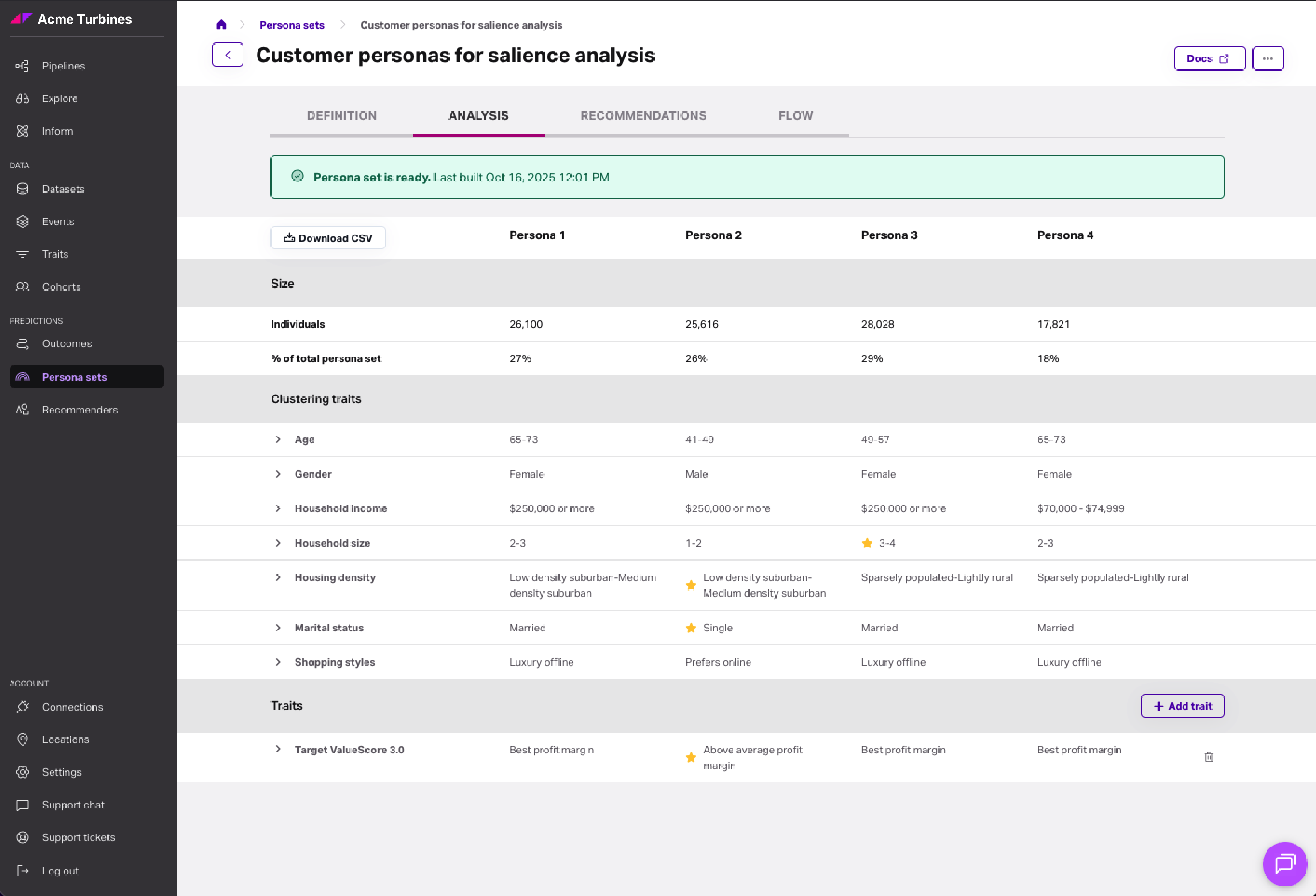What's new: Personas get interpretation features for faster insight
Faraday’s personas now include plain-English summaries, salient traits, and strategic recommendations—making it easier than ever to interpret and act on your customer insights. Building on our recent persona naming update, this release adds a new layer of clarity and context that turns analysis into action.


Marketers have always used personas to bring customer data to life. But too often, persona outputs end up feeling opaque, confusing, or overwhelming. Blurry averages flatten nuance, biased naming conventions create distraction, and long trait tables? They leave teams unsure what truly drives action.
At Faraday, we’re committed to making data and predictions easier to interpret and act on. Building on our recent persona naming update, we’re now rolling out salience-based persona interpretation features right in our existing dashboard—a major step toward clearer, bias-free insights that help marketers move from analysis to strategy with confidence.
What’s new in persona interpretation
With this release, every persona in Faraday now includes:
- Plain-English summaries A one-paragraph description of what defines the group is now found in the definitions tab so teams can immediately understand who they’re looking
- Salient traits (or datapoints)
Clear indicators of which characteristics distinguish this persona from the rest of the set are now found in the Analysis tab. In practice, this means you can see which of Faraday’s 1,500+ consumer datapoints most clearly set this persona apart from others — helping you understand what’s unique about them.
In your dashboard, these most distinctive traits are now flagged with a star. ⭐
- Strategic recommendations
Practical ideas for how to engage each persona more effectively, which turn insights into action
Together, these tools connect Faraday’s predictive data to clearer audience segmentation and campaign planning.
Why interpretation matters
Interpreting personas shouldn’t feel like decoding a spreadsheet. Historically, persona analysis has relied on modes (the most common values) and assumptions That leads to two familiar problems:
- Blurry signals — Minor differences (like 51% vs. 49%) get overstated, while meaningful behavioral patterns are buried.
- Too much noise — Lengthy trait tables provide data, but not direction.
The new interpretation features in Faraday personas cut through that clutter. Each persona now highlights only the salient traits that truly define the group, accompanied by plain-English summaries and strategic recommendations. Combined with our recent move to neutral persona naming, these updates give you a clearer, more trustworthy picture of your audiences.
Key takeaways
✅ New interpretation features make persona insights clearer and more actionable.
✅ Salient traits highlight what defines each audience segment.
✅ Strategic recommendations turn analysis into immediate next steps.
✅ New and rebuilt personas automatically include these updates.
Explore our new personas features today
This feature is now live in both the Faraday Dashboard and API. Head to your personas to see the new summaries, salient traits, and recommendations in action.
If you have questions about how to get the most out of enhanced personas, your Faraday account manager is here to help.
FAQ
Why are some cells that appear most different not starred?
Each cell represents the mode, or the most common value, of the trait for that persona. But modes don’t always tell the full story. Suppose Persona 1 shows 100K+ as its mode for income, while others show 80–100K. Persona 1 appears to be most different, yet it might actually include 51% individuals earning 100K+ and 49% earning under 80K. In that case, the mode alone doesn’t capture what distinguishes that persona’s income.
Instead, the salient labels identify which persona shows the most distinctive pattern within each trait. This process repeats for every trait. Specifically, traits that receive stars are those whose distributions most strongly differentiate that persona from others. This allows the system to highlight what truly distinguishes a persona within each trait, not just what values of traits occur most frequently.
Do I need to rebuild existing personas to see the new interpretation features?
Yes. Existing personas stay as they are, but any new or rebuilt sets include summaries, salient traits, and recommendations automatically.
Will this affect my API workflows?
No. There are no API changes—personas will simply include richer interpretation data when rebuilt.
Where do I find these updates?
In the Faraday Dashboard: summaries in Definitions, salient traits in Analysis, and recommendations in Recommendations.
Why do some traits have no starred values across any personas?
Some traits receive no stars because the data patterns for those traits are too similar. The system applies two rules before assigning a star. First, a value’s salience must exceed a minimum threshold. Second, it must be significantly higher than the salience of that same trait’s values in other personas. Only when both conditions are met does the system star a trait value.

Ready for easy AI?
Skip the ML struggle and focus on your downstream application. We have built-in demographic data so you can get started with just your PII.


